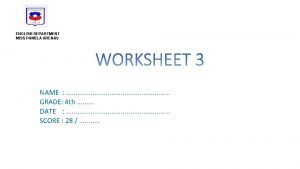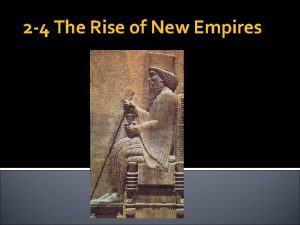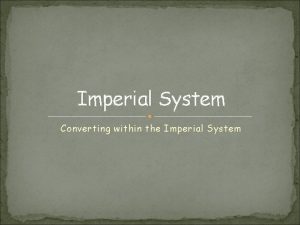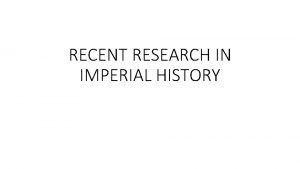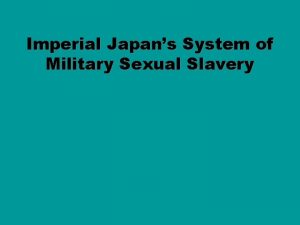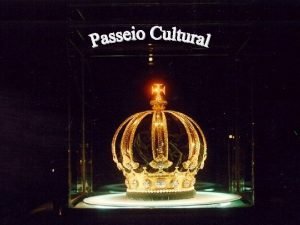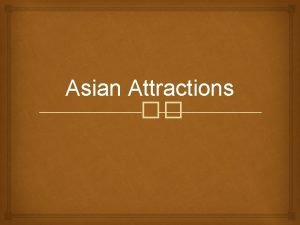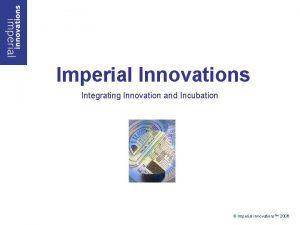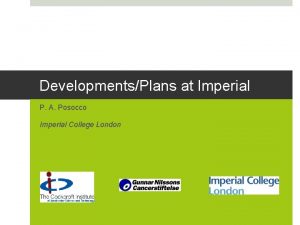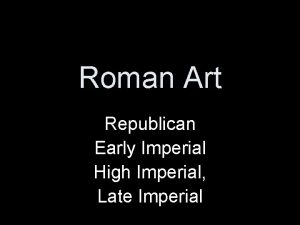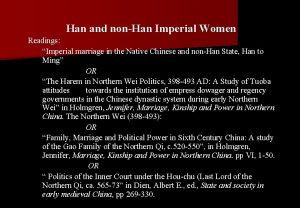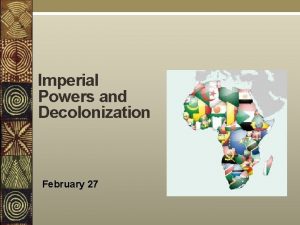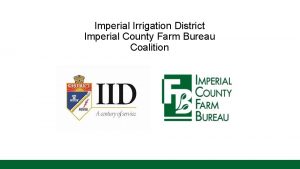Imperial Arenas New Empires in the 16 th



















- Slides: 19

Imperial Arenas New Empires in the 16 th and 17 th Centuries

Imperialism n Empires were arenas of exchange Human migration n Technology n Religion n Political ideology n Plant/animal life n n 16 th Century imperialism ended thousands of years of ecological divergence


Maritime Empires Early empires focused on people and land n New empires controlled ports and patrolled ocean routes n Precedent in early Mediterranean but reaches an oceanic scale in 16 th century n New maritime technologies allowed these empires n n New ships based on Asian designs n Sea charts based upon Asian science n Discovery and mapping of fixed wind/current systems in Pacific and Atlantic Oceans

Portuguese Imperialism n First to set up ports and trading bases throughout Africa and Indian Ocean n Mostly shippers and traders in existing Asian commercial system n n Would eventually be eclipsed by English and Dutch Least invasive of European imperialists So-called “trading-post” empire Spices such as cinnamon, pepper, and cloves Porcelain and textiles Married into local culture n n Provided business contacts for merchant Profit-sharing arrangements for wife


Japanese Imperialism n Long period of Japanese civil war ended in 1585 Left large class of professional warriors and thriving arms industry without jobs or markets n Warlord Hideyoshi began military expansion n n Turned back in China/Korea n Took Okinawa and Ryukyu Islands n After Hideyoshi’s death, isolationist reaction Some expansion N. to conquer Ainu people n In 17 th century begin conflict w/ Russia over Sakhalin island n


Dutch Imperialism n Prior to 17 th century Holland Zealand (Netherlands) were European fishing backwater n n n Initially controlled by Spain, but rebelled Entered Mediterranean and then Indian Ocean trade to finance independence Portuguese were losing influence in Asia due to religious intolerance and rising Asian nationalism n n Dutch moved in to capitalize on this vacuum Formed a joint-stock company to monopolize spice trade

Dutch-Japan Connection n Japan largest producer of silver in 16 th century world n Portuguese traded south Asian goods for Japanese silver, used silver to buy more goods, etc. n Also brought Catholic missionaries to Japan n Seen as threat by Japanese rulers Eventually kicked completely out 1639 Dutch took over trade with Japan n n Protestant nation, no missionaries Kept trade to a single port city—Nagasaki Led to 200 years of Japanese isolation from rest of Europe Massive supply of cash allowed to build large navy and drive British from East Indies, keep Spanish/French out of the East Indies, and eventually led to William of Orange taking the English throne 1688

Dutch Precedent n Dutch power led to movement from “trading-post” imperialism to territorial imperialism n n Move to control not just trade but production of commodities Other European powers followed suit Soon South-East Asia almost entirely in European hands With Europeans in control of producing areas as well as distribution, trade deficit with East Asia is reversed for the first time in history

Land Empires: Russia n Russia emerges as large scale power in 16 th century Lack of warm water ports reason Russia develops land power instead of sea power n Russian wealth built upon pursuit of furs n Russian czars conquer Kazan 1552 control Volga n n Allowed dominance of Siberian fur trade n Moved to conquer Siberia itself 1570 s n n Part of a “Crusade” against heathen tribes Holy War to spread Orthodox Christianity

Land Empires: China n While Russia focused only on resource extraction, China moved to spread culture Added outer Mongolia and Manchuria to China in the 17 th century n Cultural assimilation similar to European colonization n n Chinese schools to spread language and values n Native peoples confined to “reservations” n Militarized agricultural colonies

Land Empires: Mughal India n Est. by Babur a Central Asian warrior who conquered Delhi Sultanate in 1526 n n n Stabilized by Akbar 1556 -1605 n n n An “old-school” empire interested in imperial power and tribute states rather than trade/culture/resource Built on idea of constant conquest and expansion System of tribute from conquered states to fund future conquests 800 wives from different territories to serve as hostages and mediators of alliance Mughal Empire covers nearly all of India by 1700

Land Empires: The Ottomans n Ottomans were among the most effective imperialists the world has ever known Drew on traditions of steppelands, Islam, and Rome n Richest country in world during 16 th and 17 th centuries n n Dominated all non-oceanic spice trade n Taxed Russian fur trade through Bosporus n Had to be stable to deal with threats from Christians and Safavids

Ottoman Expansion n n Conquered Mamluk Egypt in 1517 Suleiman the Magnificent 1520 -1566 conquered the Balkans and most of Hungary n n n Finest land army in the world for 200 years Able to move quickly over well-maintained road system, could fight on three fronts in one season Expansion slowed because of diminishing returns n n Rather than outstrip communication, allowed diplomacy and tribute Used many different methods of security and control

Spanish Empire in the Americas n n Spain moves from being a poor and backward kingdom to the world’s leading power in about 50 years Began with Columbus’ war of conquest in Hispaniola 14951496 Moved through Caribbean to Mexico and Peru by 1546 Spanish conquistadores really just catalyst for oppressed Native allies to overthrow Aztec and Incan overlords n n n Hernan Cortez Vasco Balboa Francisco Pizarro Disease then decimated the native populace Spanish Empire built on achievements of native tributary people n Rebellions

Euro-American Empires Contrasted n Spanish first to arrive and conquered largest, most productive regions n n Labor needs met by native populace Intermarriage Portuguese maintained small scale ports in Brazil based upon the Treaty of Torsedillas 1494 English and French as latecomers left with less productive regions n n n Natives could not meet labor needs Leads to radically different types of colonies English relied on imported labor and focused on exclusion or extermination of native peoples

The New Balance of Global Trade n New World finally provided Europe with resources to economically rival India and China Built up internal New World economies, estab. new N-S connections n Cross-oceanic trade in gold and silver n n Spanish Treasure Fleets n Pacific trade with China n By mid 1500 s, ALL major world trade routes were connected
 Land empires vs maritime empire
Land empires vs maritime empire Estadio aconcagua arena mendoza
Estadio aconcagua arena mendoza Don bosco 88
Don bosco 88 When does her wonderful adventure begin?
When does her wonderful adventure begin? Guided reading activity 2-4 the rise of new empires
Guided reading activity 2-4 the rise of new empires đặc điểm cơ thể của người tối cổ
đặc điểm cơ thể của người tối cổ Tỉ lệ cơ thể trẻ em
Tỉ lệ cơ thể trẻ em Tia chieu sa te
Tia chieu sa te Các châu lục và đại dương trên thế giới
Các châu lục và đại dương trên thế giới ưu thế lai là gì
ưu thế lai là gì Các môn thể thao bắt đầu bằng từ đua
Các môn thể thao bắt đầu bằng từ đua Tư thế ngồi viết
Tư thế ngồi viết Hát kết hợp bộ gõ cơ thể
Hát kết hợp bộ gõ cơ thể Cái miệng nó xinh thế
Cái miệng nó xinh thế Mật thư tọa độ 5x5
Mật thư tọa độ 5x5 Tư thế ngồi viết
Tư thế ngồi viết V cc cc
V cc cc Chó sói
Chó sói Thẻ vin
Thẻ vin Thể thơ truyền thống
Thể thơ truyền thống



